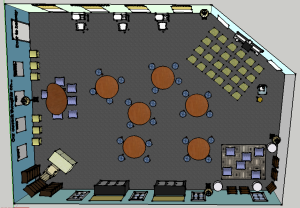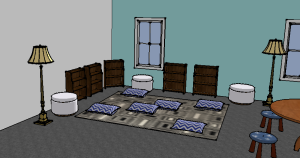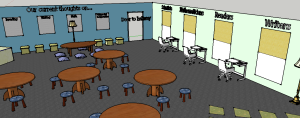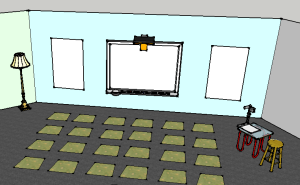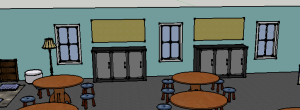This week in CEP811 we were introduced to the concept of experience design in the classroom. Research states “that the classroom environment can affect a child’s academic progress over a year by as much as 25%” (University of Salford Manchester, 2012). This, to me, is a striking statistic that makes me wish I had taken some sort of design course in college. After learning about design through this week’s activities, we were tasked with thinking about a familiar learning space and deciding whether this space works for what we know about learning today, or just learning in the past.
I chose to think about my classroom from my first year of teaching. I was in a large, spacious room that had five walls – two longer walls parallel to one another, and three other walls more angled and shorter. I was not really happy with how my library was set up along a back wall instead of being a separate space. Students didn’t really have any space to sit and read unless it was randomly around the classroom on the floor. Their square desks were arranged in tables and it was difficult navigating between them.
I imagine this space being restructured in a more practical, learner-centered way. Students work at round tables to encourage collaboration, which is in line with the theory of cooperative learning. Students grouped together in learning enhance their interpersonal skills (Hsiung, 2012, p. 120). They learn and support one another through conversation and exploration of concepts. Cooperative learning has proven that when students work together as learners, their attitudes, retention, and achievement are also enhanced (Hsiung, 2012, p. 119). I redesigned the library to include a rug area and ottomans to sit and work on. In front of the SmartBoard are individual carpet squares to move into any arrangement. Students will make their own choices for where they will work and with how many peers.
[The door into the room is in the top left corner – “door to hallway” text covers the door. Image credit: Whitney Cornelli]
After reading Trung Le’s (2010) article about the practicality of Kindergarten classroom design, I knew right away that I wanted to change the “direction” of my room. In Kindergarten classrooms, Le notices there is no real “front” of the room – every surface and wall displays student work, and students work all around the room (Le, 2010). I moved my SmartBoard to a smaller wall, off to the side. Since student desks are no longer perfectly situated in front of a board, students work more independently and rely less on the teacher up front. There are anchor charts behind my kidney table. Where the computer desks are, students use the top half to post their work and the bottom to actually work through problems on dry-erase boards. There are dry-erase boards on both sides of the SmartBoard to encourage students to show their work and not have it be erased before we can move on.
[Image credit: Whitney Cornelli]
The cupboards on the wall with the windows hold math and science manipulatives. The bulletin boards above display student work in progress. As part of experience design, displaying student work, whether current or older, allows for visible tracking of progress (The Third Teacher, 2010, card 15). Anchor charts and individual subject bulletin boards allow students to always have a look at the class’s work!
[Image credit: Whitney Cornelli]
To implement my vision, I would need some help. My district closed an elementary building and had a public auction of furniture. I could have taken: circle tables, a kidney table, desk and chair, lamps, computer desks/chairs, small table/chair for the document camera, cupboards, and tall bookcases. I already have four pillows. I still need to purchase:
-Twenty-four stools: $480.00 ($19.99 each) [Ebay]
-Seven pillows: $14.00 ($1.99 each) [Ikea]
-Area rug: $168 [Home Depot]
Twenty-four carpet squares: $238.80 (3 cases at $79.60/case) [Home Depot]
-Three circular storage ottomans: $240.00 ($79.99 each) [Target]
-Six square storage ottomans: $102 ($16.88 each) [Walmart]
My redesign would involve other staff in the building, janitorial staff, and the Board of Education. The redesign would best take place over the course of the summer, when contractors and myself can come and go as needed. Because of this, it would not all have to happen at once… but it would need to be completed by early August!
References:
Hsiung, Chin-Min. (January 2012). The Effectiveness of Cooperative Learning. Journal of Engineering Education, 101(1), 119-137. Retrieved from http://search.proquest.com.proxy2.cl.msu.edu/docview/1014006079/fulltextPDF/6583510BCC394469PQ/1?accountid=12598.
Le, Trung. (4 May 2010). Redesigning Education: Why Can’t We Be In Kindergarten for Life? Fastcodesign (website). Retrieved from http://www.fastcodesign.com/1637619/redesigning-education-why-cant-we-be-in-kindergarten-for-life.
The Third Teacher. (2010). The 79 Flash Cards. Retrieved from http://static.squarespace.com/static/509c0d15e4b058edb8f35a86/t/50ec7590e4b0a0ad0261576c/1357673872861/TTTIdeasFlashCards.pdf.
University of Salford Manchester. (9 November 2012). Study proves classroom design really does matter. University of Salford Manchester (website). Retrieved from http://www.salford.ac.uk/news/study-proves-classroom-design-really-does-matter.
